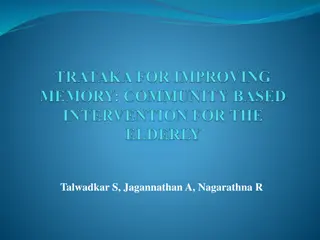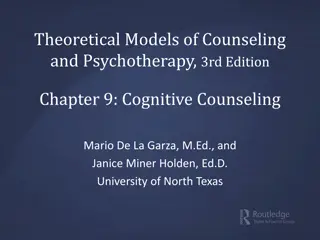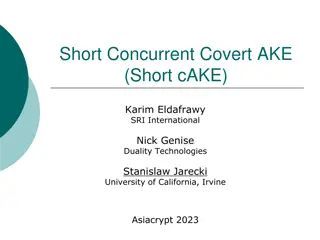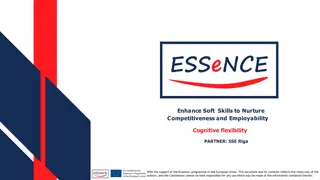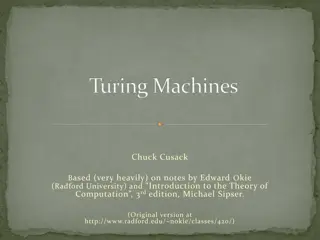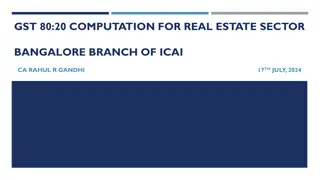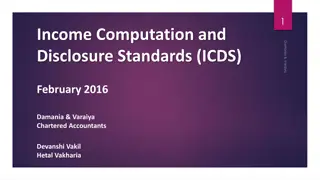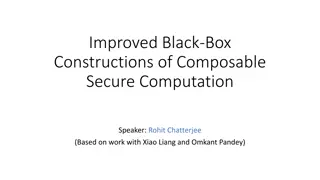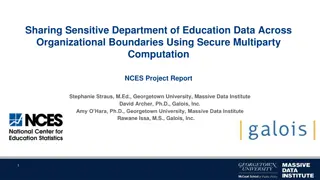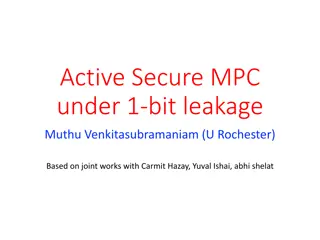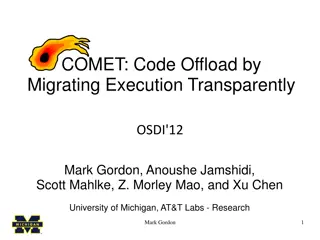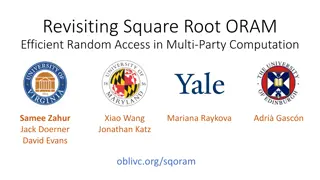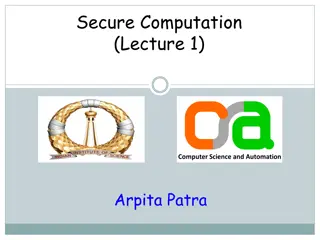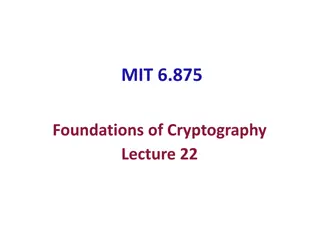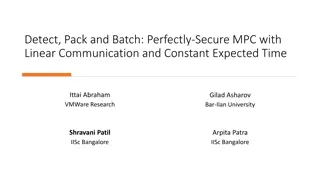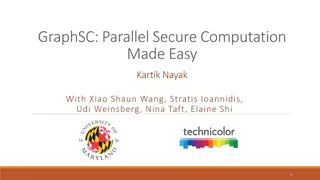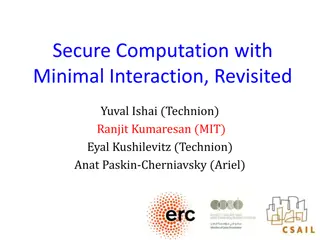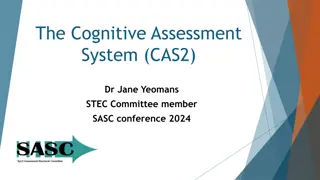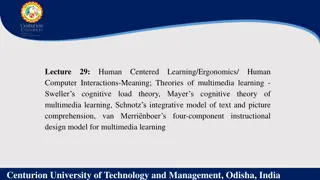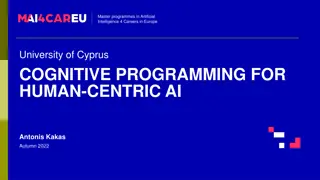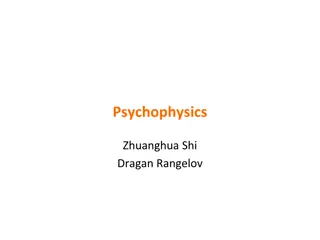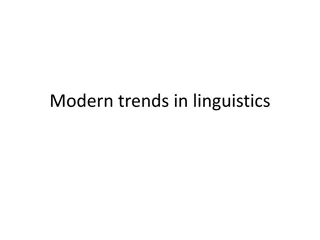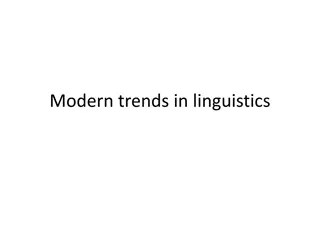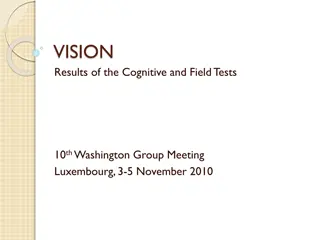Overview of Cognitive Computation Group Curator Tools
The Cognitive Computation Group Curator provides a range of NLP tools for tasks such as Tokenization, Part-Of-Speech Tagging, Named Entity Recognition, and more. Users can access these tools in various programming languages like Python, Java, and Perl, with a focus on creating efficient NLP pipelines. The Curator simplifies the use of multiple NLP resources, offers a single point of contact for NLP tasks, and supports a common interchange format for seamless integration. By utilizing Curator, researchers and developers can enhance their NLP applications with a configurable and high-performance pipeline.
Download Presentation

Please find below an Image/Link to download the presentation.
The content on the website is provided AS IS for your information and personal use only. It may not be sold, licensed, or shared on other websites without obtaining consent from the author. Download presentation by click this link. If you encounter any issues during the download, it is possible that the publisher has removed the file from their server.
E N D
Presentation Transcript
Cognitive Computation Group Curator Overview December 3, 2013 http://cogcomp.cs.illinois.edu
Available from CCG in Curator Tokenization/Sentence Splitting Part Of Speech Chunking Lemmatizer Named Entity Recognition Coreference Semantic Role Labeling Wikifier 3rdparty syntactic parsers: Charniak Stanford (dependency and constituency) Page 2
Academic research use of NLP tools Find tools written in the language you re programming with, e.g. python, Java, perl, c++ with a nice API public class myApp { POSTagger tagger; . public Result doSomething( String text ) { List< Pair< String, String > taggedWords = tagger.tag( text ); } Page 3
Using NLP tools (contd) OR maybe, it s written in Ocaml and only runs from the command line and writes to a file so write a shell script that runs the first tool and pipes its output to your tool and write a parser to map from that output to your data structures or maybe you could learn Ocaml and write a web service wrapper... Generally, people either tend to use a lot of File I/O and custom parsing -- cumbersome and usually extremely non-portable. Use a specific package in a specific language (e.g. NLTK), and stick to it. Write all their own tools. Page 4
The growing problem Usually, complex applications like QA benefit from using many NLP tools. For many tasks e.g. POS, NER, syntactic parsing there are numerous packages available from various research groups. But they use different languages and different APIs and you don t know for certain which tool of each type would be the best, so you d like to try out different combinations and as tools get more sophisticated, they tend to need more memory. CCG tools: Old NER: 1G; Old Coref: 1G; SRL/Nom: 4G each; new NER: 6-8G; Wikifier: 8G . Even if they are all in Java, you may not have a machine that can run them all in one VM. Page 5
CURATOR Page 6
Curator NER Curator SRL POS, Chunker Cache Page 7
What does the Curator give you? Supports distributed NLP resources Single point of contact Single set of interfaces Common interchange format (Thrift) Code generation in many programming languages (using Thrift) Programmatic interface Defines set of common data structures used for interaction Caches processed data Enables highly configurable NLP pipeline Overhead: Annotation is all at the level of character offsets: Normalization/mapping to token level required Need to wrap tools to provide requisite data structures Page 8
Getting Started With the Curator http://cogcomp.cs.illinois.edu/curator Installation: Download the curator package and uncompress the archive Install prerequisites: thrift, apache ant, boost, mongodb Run bootstrap.sh The default installation comes with the following annotators (Illinois, unless mentioned): Sentence splitter and tokenizer POS tagger Lemmatizer Shallow Parser Named Entity Recognizer Coreference resolution system Stanford and Charniak parsers Semantic Role Labeler (+ Nominalized verb RL)
Basic Concept Different NLP annotations can be defined in terms of a few simple data structures: 1. Record: A big container to store all annotations of a text 2. Span: A span of text (defined in terms of characters) along with a label (A single token, or a single POS tag) Node: A Span, a Label, and a set of children (indexes into a common list of Nodes) 4. Labeling: A collection of Spans (POS tags for the text) 5. Trees and Forests: A collection of Nodes (Parse trees) 6. Clustering: A collection of Labelings (Co-reference) Note: spans use one-past-the-end indexing The at beginning of sentence has character offsets 0,3 3.
Spans, Labelings, etc. The Span is the basic unit of information in Curator s data structures. A Span has a label, a pair of offsets (one-past-the-end see the Labeling/Span example further on), and a key/value map to contain additional information While the different data structures (Labelings, Trees, etc.) are provided with specific uses in mind, there are no specific constraints on how any given application represents its information Part of Speech will probably use the Span label to store POS information, but the key/value map could be used instead Coreference may store additional information about mentions in a mention chain in their key/value maps Page 11
Example of a Labeling and Span The tree fell.
Example of a Tree and Node The tree fell.
Example of a Clustering John saw Mary and her father at the park. He was alarmed by the old man s fierce glare. Labeling 1: [E1; 0,4 (John)], [E1; 43,45 (He)] Labeling 2: [E2; 10,14 (Mary)], [E2; 20,23 (her)] Labeling 3: [E3; 20, 29 (her father)], [E3; 59, 61 (the old man)]
Using Curator for Flexible NLP Pipeline http://cogcomp.cs.illinois.edu/curator/demo/ Setting up: Install Curator Server instance Install components (Annotators) Update configuration files Use: Use libraries provided: curatorClient.provide() method Access Record field indicated by Component documentation/configuration Page 15
Record Data Structure struct Record { /** how to identify this record. */ 1: required string identifier, 2: required string rawText, 3: required map<string, base.Labeling> labelViews, 4: required map<string, base.Clustering> clusterViews, 5: required map<string, base.Forest> parseViews, 6: required map<string, base.View> views, 7: required bool whitespaced, } rawText contains original text span Annotators populate one of the <abc>Views, assign a unique identifier (specified in configuration file) Page 16
Annotator Example: Parser Will populate a View, named charniak Curator will expect a Parser interface from the annotator Client will expect prerequisites to be provided in other Record fields Specified via Curator server s annotator configuration file: <annotator> <type>parser</type> <field>charniak</field> <host>mycharniakhost.uiuc.edu:8087</host> <requirements>sentences:tokens:pos</requirements> </annotator> Page 17
Using Curator (Java) snippet <1> public void useCurator( String text ) { // First we need a transport TTransport transport = new TSocket(host, port ); // we are going to use a non-blocking server so need framed transport transport = new TFramedTransport(transport); // Now define a protocol which will use the transport TProtocol protocol = new TBinaryProtocol(transport); // instantiate the client Curator.Client client = new Curator.Client(protocol); transport.open(); Map<String, String> avail = client.describeAnnotations(); transport.close(); for (String key : avail.keySet()) System.out.println(``\t'' + key + `` provided by '' + avail.get(key)); boolean forceUpdate = true; // force curator to ignore cache Page 18
Curator snippet (Java) <2> // get an annotation source named as 'ner' in curator annotator // configuration file transport.open(); record = client.provide( ner , text, forceUpdate); transport.close(); for (Span span : record.getLabelViews().get( ner ).getLabels()) { System.out.println(span.getLabel() + `` : '' + record.getRawText().substring(span.getStart(), span.getEnding())); } ... } Page 19
Curator snippet (php) <1> function useCurator() { // set variables naming curator host and port, timeout, and text ... $socket = new TSocket($hostname, $c_port); $socket->setRecvTimeout($timeout*1000); $transport = new TBufferedTransport($socket, 1024, 1024); $transport = new TFramedTransport($transport); $protocol = new TBinaryProtocol($transport); $client = new CuratorClient($protocol); $transport->open(); $record = $client->getRecord($text); $transport->close(); Page 20
Curator snippet (php) <2> foreach ($annotations as $annotation) { $transport->open(); $record = $client->provide($annotation, $text, $update); $transport->close(); } foreach ($record->labelViews as $view_name => $labeling) { $source = $labeling->source; $labels = $labeling->labels; $result = ``''; foreach ($labels as $i => $span) { $result.= ``$span->label;''; ... } ... Page 21
Benefits From the user s (i.e., developer of complex text processing applications) perspective, Programmatic interface in their language of choice Uniform mechanism for accessing a wide variety of NLP components Caching of annotations, which can be shared across a group Distribution of memory-hungry components across different machines, but with one point of access For the more adventurous, an extensible framework that can be changed via the specification of the underlying Thrift files Page 22
Edison A Java library by Vivek Srikumar of CCG that Simplifies access to Curator Defines useful NLP-friendly data structures Provides code for a lot of common NLP tasks, e.g. feature extraction, calculation of performance statistics, http://cogcomp.cs.illinois.edu/page/software_view/Edison The link above provides examples for using Edison and Curator together Page 23





